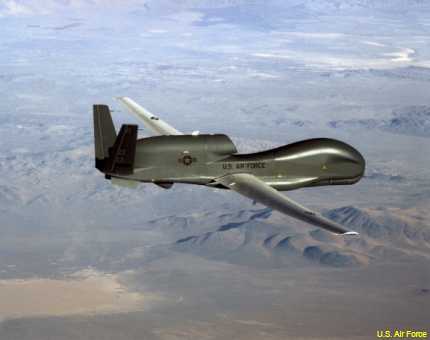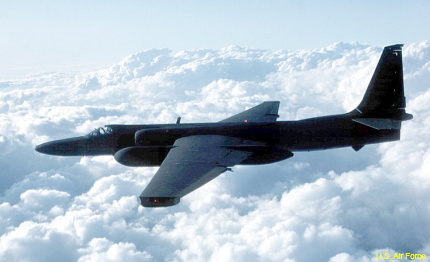The future of ISR is unmanned, whether commanders like it or not
Air Force officials see the U-2 and Global Hawk as complementary, but they’ll soon have to do without one of them.

The Global Hawk, favored by Congress, is capable of 30-hour flights.
It’s no secret that unmanned aerial systems are a favorite tool of the military when it comes to counterterrorism operations and intelligence, surveillance and reconnaissance, or ISR. But this singular preference seems to translate only to medium-altitude, long-endurance aircraft, or MALE, such as the MQ-1 Predator and its larger cousin, the MQ-9 Reaper, both of which can be outfitted with lethal payloads. Up at higher altitudes, support for UAS isn’t so uniform.
The battle concerning high-altitude ISR has been billed as a faceoff between the Air Force’s RQ-4 Global Hawk – capable of staying aloft at 65,000 feet for over 30 hours – and the Cold War relic U-2, which is listed as having an unclassified ceiling of 70,000. The U-2 has its advantages, although the aircraft’s nickname, Dragon Lady, is a reference to its “unforgiving” nature that makes it very difficult for the lone pilot to fly. As such, there are a limited number that can perform the 10-hour flight missions required to fly the U-2.
Though the U-2 is still flown today (it was first deployed in the 1950s, but the latest models were built in 1989), it was thought that the unmanned platforms would be the future of the force and serve “potentially [as] a replacement for the U-2” despite early designs “not currently match[ing] the U-2's intelligence gathering capabilities,” a Congressional Research Service Report said in 2000.
The Air Force has been back and forth on the issue. For years, the service wanted to shutter the Global Hawk program in favor of keeping the U-2, which at the time cost less to operate, but met stiff resistance from Congress, which favored the Global Hawk. The Air Force then reversed its position in March this year, after the operating costs for the Global Hawk Block 30 fell below those of the U-2.
The U-2 was slated for retirement in the 2015 budget but was revived until 2019. Presently, due to continued budget restraints, it appears unmanned systems will be the future in the high altitude ISR domain, although, from a mission perspective the Air Force would prefer that it not be an either/or debate.
“[T]he AF views the U-2 and RQ-4 as complementary systems and acknowledges the Combatant Command demand for more ISR; however the current fiscal environment does not allow the AF to maintain both platforms when either alone can meet the combat requirements,” a spokesperson within the Secretary of the Air Force – which is responsible for procurement – told Defense Systems via email. “Congressional restrictions on retiring either platform forced another look at the situation. Long-term affordability after near-term investments provides a stronger case for the RQ-4.”
While the Air Force will not procure any additional Global Hawks, as outlined in the most recent budget proposal, the service announced earlier this year it would spend $4 billion on the program over the next five years and in late September awarded Northrop Grumman a contract worth up to $ 3.2 billion for modernization and maintenance, which could include upgrades to the aircraft’s electro-optical sensors.
“The FY15 President's Budget provides investments to transition unique U-2 sensors to the Block 30, mitigating gaps in collection capabilities and increasing operational reliability, including improved performance in inclement weather and avoiding conditions previously resulting in early recovery or flight cancellations,” the Air Force spokesperson said.
This has potentially set up a contractor dispute between Northrop and Lockheed Martin, the U-2’s manufacturer, which is developing a manned successor to the U-2 called the TR-X.
Front-line resistance
For now, the era of budget austerity imposed by caps in the Budget Control Act of 2011 makes the Global Hawk an attractive option for decision-makers, if not necessarily operational commanders. Air Force Maj. Gen. Linda Urrutia-Varhall, assistant deputy chief of staff of ISR, recently described how top brass continue to suggest placing payloads on Global Hawks rather than continuing to rely on larger manned aircraft such as the Joint Surveillance Target Attack Radar System.
“[The Office of the Secretary of Defense] is convinced, they go ‘Oh, we don’t need Joint STARS, you can hang it on a Global Hawk.’ We’re like ‘No!’ You can’t – it’s not a one-for-one…We need the Joint STARS ’cause it’s bigger,” Urrutia-Varhall told Defense Systems following her remarks at an AFCEA luncheon.
“The Global Hawk’s going have so much crap hanging off of it, it’s not even going be able to take off,” she said to the audience, in reference to Congress’s insistence on using the Global Hawk to solve all ISR challenges. According to Air Force fact sheets, the U-2 holds a 2,000 pound greater payload capacity than the Global Hawk.

The Air Force still prefers the venerable U-2 for some missions.
“The U-2 was decided upon as being retired and the Global Hawk going to pick up some of the –not all of – but some of the capabilities of the U-2,” said Lt. Col. Timothy McDonald, deputy of ISR Requirements at the Air Force’s Air Combat Command. “Now when it was designed, it wasn’t really designed to be a replacement for the U-2 and so we’re having to do a lot of adjustments to the RQ-4, the Global Hawk, in terms of capability to its sensors and that’s really what’s been consuming a lot of our time here at [Air Combat Command] is that issue with getting the Global Hawk to cover some of those capabilities that were identified as specifically being U-2.”
“Our challenge is right now,” McDonald said, “is how do we get those capabilities onto the RQ-4? It’s proving challenging due to those – not only from a cost standpoint, but due to the size, weight and power limitations as well. [The Global Hawk] doesn’t have the same room and it doesn’t have the same payload capacity and it doesn’t have the same power that the U-2 has.”
End of an era
“The world of manned reconnaissance is gone, and soon manned reconnaissance itself will be gone,” Charlie Allen, former assistant director of central intelligence for collection at the CIA, said in a recent interview with Breaking Defense. “I think we’ll move almost solely to unmanned reconnaissance, whether it’s long range in the class of Global Hawk or whether it deals with Predator A’s (or) Predator B’s,” he said, also indicating that the shoot down of Gary Powers’ U-2 over Soviet territory in 1960 is one of the driving factors; “If you lose one [UAS], you will not have lost a pilot,” he said.
However, McDonald disagrees with the notion that the U-2 and Global Hawk should be compared as competing systems and warned that the issue should not be viewed necessarily as manned vs. unmanned, since both the U-2 and Global Hawk are complementary systems, each better poised for certain mission sets. “It’s not one really is better than the other. It’s that they are very complementary in what they do…they’re very hard to compare because they’re so good at helping each other out,” he said. This echoes what Air Force Lt. Gen. Robert Otto, deputy chief of staff for ISR, has said, that “going manned or unmanned is ‘really mission specific.’”
When talking about mission sets, the key question concerns requirements, McDonald said. He said each combatant command has ISR requirements based on their targets – be it imagery intelligence, signals intelligence, and so on. There are certain requirements that the U-2 is better at and some that the Global Hawk is better at. For example, some targets might require an extreme amount of endurance that the U-2 is just not capable of, while other targets might need specific payloads that are only carried by the U-2, such as the wet film camera. “The manned/unmanned [debate] doesn’t really enter into how those…mission targets are able to be collected,” McDonald said. “It’s really on which platform is the best to get those targets.”
Otto explained recently that he is sympathetic to the argument that unmanned reconnaissance flights will increase – especially over dangerous territory. “If you’re going into contested airspace when you’re not otherwise at general war, it’d be a heck of a lot better to lose an unmanned airplane than a manned airplane. We proved that with Francis Gary Powers,” he said.
Unfriendly skies
Otto’s comments point to another issue raised by Allen and others, which is the concern of unmanned aircraft operation in contested airspace or anti-access area denial (A2/AD). One of the reasons the MALE aircraft have been so successful in counterterrorism operations is that they fly in permissive environments. With emerging threats from nation-states with much more capable radar and anti-aircraft systems – not to mention the Asia rebalance in which maritime ISR in contested environments is a key pillar – unmanned aircraft might be marginally less effective.
“The way of the future is through unmanned reconnaissance. For a whole variety of tasks, using a wide range of payloads. Certainly for non-denied areas,” Allen said. “For denied areas, there will be, inevitably, systems that will be used for denied areas as well. That’s all I can say about that.” Manned aircraft typically fly faster than UAS and are more easily maneuverable – and have the advantage of the quick reaction abilities of pilot in the cockpit as opposed to one working remotely.
“What I would say about the contested and highly contested environments is that we’re working on solutions to attack that problem in terms of our high-altitude ISR realm,” McDonald said. “Again, the Global Hawk vs. the U-2 – the U-2 has some defensive capabilities onboard, whereas the Global Hawk is unmanned.”
Otto lauded the endurance capabilities of unmanned systems, given that humans are limited by a 13-hour window while systems such as the Global Hawk can fly for 30 hours. But there is no substitute for a pilot in the cockpit if outside circumstances or conditions create complications. “We also have found, like in Afghanistan and Iraq, that when the weather’s kind of crummy, manned airplanes have a higher mission success rate because there’s somebody there that can dodge the weather and understands the intent and can work their way to a successful mission accomplishment,” Otto said. “So while I think the future looks bright for unmanned airplanes, and especially in unmanned reconnaissance, I do believe that there are some roles today that manned airplanes are a better fit.”
Because of its endurance, the Global Hawk can take off from a base and travel thousands of miles, collect ISR data and come back on one sortie, McDonald said. While the U-2 can’t do this, the trade-off is payload capacity.
“[D]ifferences in altitude capabilities will still remain,” the Air Force spokesperson said. “Manned assets deploy faster and it is easier to get approval to conduct operations in international or coalition airspace. Also, because [remotely piloted aircraft] require nearly continuous connectivity, it is currently simpler in many situations to have a person able to respond and improvise in the moment. For the foreseeable future we need to leverage the strengths of both manned and unmanned platforms.”
Presently, the future of high-altitude ISR appears to be unmanned, more because of budgetary restriction than the advanced capabilities of UAS. If combatant commanders had their druthers, they have both manned and unmanned flights. But that’s unlikely. McDonald and almost all other combat commanders just want more ISR, regardless of the platform, provided it meets mission requirements. “Whether our leaders decide that the U-2 or the Global Hawk is the way to go – they’ve decided the Global Hawk is,” McDonald said. “If money wasn’t an object – I can’t imagine living in that world ’cause money is always an object…I would buy more” ISR.